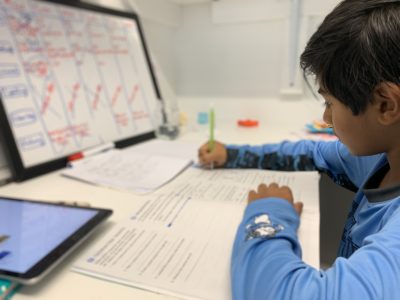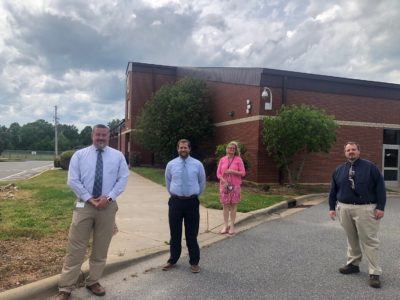
As families embark upon a school year like none before, most public school districts in North Carolina are largely relying on a household’s ability to access a high-speed internet connection to provide students their constitutionally guaranteed access to a sound basic education.
But the COVID-19 pandemic has laid bare the profound inequities that exist across North Carolina when it comes to accessing broadband internet, defined as a download rate of 25mpbs or greater. And while physical broadband infrastructure problems plague many rural parts of the state, the problem is not limited to certain geographic areas — in fact, barriers to high speed internet exist in urban areas, too.
“The digital divide is not restricted to just one population in our state,” said Jeff Sural, Director of the Broadband Infrastructure Office at the NC Department of Information Technology. “It’s actually a statewide problem that spans many demographics. The causes and impacts are different — while in the rural parts of our state, there is often a lack of physical access due to either remoteness or hard-to-drill terrain in the mountains, in our urban areas the huge challenges include affordability, relevancy, a lack of digital literacy skills, and more.”
When looking at the numbers in relation to the rural/urban digital divide, there’s a narrative that pits the urban communities against the rural ones — and the impression is that, while rural areas are really suffering under the absence of a robust broadband internet infrastructure network, urban areas are in better shape due to the increased likelihood of broadband connectivity. Closer scrutiny reveals that when you consider all of the complex ways in which people living in urban areas cannot access the internet, the numbers are even greater in those locales. That’s a reality that Bruce Clark, the executive director of Digital Charlotte, a nonprofit organization housed at Queens University of Charlotte that works toward empowering organizations to deliver digital and media literacy resources to their communities, wants everyone to understand.
“[Access to high-speed internet] should be one of the most unifying rural/urban issues in our state,” said Clark.
Digital access requires more than a physical connection
North Carolina’s broadband deployment rate, or the availability of broadband infrastructure, is approximately 95% — among the highest deployment rates in the southeastern states according to the NC Department of Information Technology’s Broadband Infrastructure Office. However, while the infrastructure is robust in many areas (less so in sparsely populated ones), the state’s broadband adoption rate — that is those households that are actually subscribing to broadband internet service plans — is significantly lower at 59.4%.
There are a number of barriers to broadband adoption that exist across North Carolina.
Affordability
For many households, even if broadband infrastructure were present in the community, the cost for an internet service plan — as well as affording a device to access the data — is a formidable barrier.
“We know that a significant segment of the population couldn’t afford internet before the pandemic, and now even more are struggling,” said DIT’s Sural.
Just shy of 40% of households across our state have access to a wired broadband internet connection that costs less than or equal to $60 per month. In North Carolina, nearly half of all children live in households that are classified as poor or low-income, making it nearly impossible for a household to choose internet and devices over putting food on the table.
For largely rural communities that are classified as economically distressed and lack the necessary broadband infrastructure to access high-speed internet, North Carolina’s Growing Rural Economies with Access to Technology (GREAT) Grant Program has doled out tens of millions of dollars directly to Internet Service Providers (ISPs) to connect those households to the internet — and earlier this month, the NC General Assembly appropriated a new infusion of $30 million in COVID relief funds for the GREAT Grant Program to distribute.
But in terms of lowering broadband service plan costs for households, the GREAT Grant Program doesn’t contain provisions that would require ISPs to offer more affordable plans, although that’s been on the wishlist for Sural, who says he’s been pushing to have that language added to the list of requirements for ISPs wishing to receive GREAT grant funding.
According to DIT’s website, three ISPs do provide discount internet service plan options for low-income households across the state, but it’s unclear how widely accessible or robust these plans are for the vast majority of those wishing to access affordable high-speed internet, both from a cost standpoint and availability of infrastructure.
One option to mitigate the cost barrier, says DIT’s Jeff Sural, is to offer customers short term federal and/or state assistance.
“We’ve pushed for [state and/or federal] subsidies,” says Sural. “Another option is to offer tax incentives to encourage ISPs to accept the federal Lifeline grants.”
Since 1985, the federal Lifeline Program for Low-Income Consumers “has provided a discount on phone service for qualifying low-income consumers to ensure that all Americans have the opportunities and security that phone service brings, including being able to connect to jobs, family and emergency services,” according to the program’s website.
In 2016, the Federal Communications Commission (FCC) modernized the Lifeline program to include access to broadband internet, recognizing that in order to participate in today’s modern economy, internet access is critical.
Modernizing the federal grant program even further could provide another avenue through which broadband internet access could become more affordable for those who need help.
Relevancy
Another barrier? Relevancy. For many who don’t opt into broadband, the internet doesn’t appear to hold the necessary keys to everyday living.
“There are two barriers that have reared their head,” said Michael Abensour, the executive director of the Kramden Institute, Inc., based in Raleigh, which provides refurbished devices and digital literacy training primarily to students living in low-income households. “A good broadband connection and this idea of relevancy.”
Relevancy is the concept that if the internet doesn’t serve as a gatekeeper to a person’s ability to work, or doesn’t appear to serve as a means toward accessing jobs, healthcare or education, then that person is less likely to pursue the adoption of a high-speed internet connection, as they don’t see it being relevant to their lives. Relevancy often overlaps with cost, too, because in high poverty households, if the choice is, once again, between food or internet, and internet doesn’t hold relevancy in terms of successful day-to-day living, then the choice to make is clear.
Kramden says the internet’s lack of relevancy to the lives of many low-income households translates to a dearth of digital literacy skills, which comes at a time when these skills are suddenly needed in homes across the state, nation, and world as students stay home to mitigate the spread of COVID-19 and access their education through virtual platforms.
Even before the pandemic, Abensour says that as his organization worked to get devices in the hands of students, he realized he was fielding so many questions from parents, such as, “What’s a right or left click? What’s a ‘window?’ or “How do I turn this computer on?”
Abensour was then motivated to provide digital literacy training to adults in the community and develop a statewide train the trainer program.
Digital literacy skills and digital inclusion is a statewide focus for BAND-NC, a new program funded principally by the Belk Endowment and run in partnership with the Broadband Infrastructure Office and the Institute for Emerging Issues (IEI) at North Carolina State University.
BAND-NC is currently providing rapid-response community innovation mini-grants to communities across the state that will fund local digital inclusion projects that provide access to the internet, devices, and the digital literacy skills necessary to use those devices.
“We want to be the first state in the nation where every county has a digital inclusion plan in place,” said Maggie Woods, who works with BAND-NC on behalf of IEI. This past summer, BAND-NC provided $5,000 mini grants to address immediate digital connectivity and literacy needs, such as getting hot spots to communities who need them, supporting digital mapping efforts to uncover where the need is, and funding “digital navigators” — similar to health care navigators — so that households who need assistance can quickly learn what kind of internet options and devices are available to them and attain basic literacy skills so that they can access remote learning successfully.
This fall, BAND-NC will host virtual workshops that help counties learn how to build digital inclusion plans. Next spring, the program will open up another round of grants intended to assist those counties in the actual implementation of their plans.
“We are hoping to address this challenge that is the digital inclusion component,” said Woods. “We know that Wake County has almost 100% access to high speed internet, but 80% of households subscribe. For that remaining 20%, the chief barrier is cost, but also other barriers, like relevancy and digital literacy.
“So we’ve tried to reframe the conversation on not just focusing on infrastructure and technology itself– but how do you build digital and equitable communities?” said Woods.
A multi-faceted, short-and long-term approach to eliminating the digital divide
There are cross-sector, bipartisan efforts ongoing to eliminate the digital divide — but it’s critical to understand where the disconnect lies in order to implement long-term, structural solutions that cover the entire state.
“We need accurate data, and that includes mapping where households do or don’t have internet access,” said DIT’s Jeff Sural.
The federal data that is relied upon for grant-making and funding areas that are unserved is simply inaccurate, said Sural. That’s why his office launched a statewide survey earlier this year to gather clear data that will guide investment of funds through the state’s GREAT grant program, inform research and policy recommendations, and support strategic targeting of additional funding streams. (You can take that survey here.)
The SpaceX Starlink program, an innovative effort to solve challenging infrastructure problems that largely rural areas are grappling with, could be a viable option. Starlink is a low-orbit satellite program that could offer broadband internet connectivity to rural parts of the state where laying fiber is a challenging ordeal. So far, the program has 600 satellites in orbit, and customers would access the internet connectivity that is beamed from satellites by purchasing small user satellite terminals that look similar to satellite dishes used to receive a cable signal.
The State Board of Education has expressed interest in participating in a pilot here in North Carolina. Senate Bill 212, passed into law earlier this year, would open the door for North Carolina’s participation in a Starlink pilot, said Freebird McKinney, the legislative liaison for the State Board of Education and a former North Carolina Teacher of the Year. It’s an ongoing conversation, he says, that has bipartisan support.
While broadband connectivity is a challenge that must be addressed in terms of long-term solutions, near-term actions are paramount to ensuring that all North Carolinian children have access to a sound basic education during a pandemic that currently requires stay-at-home, virtual learning measures to mitigate the virus’ spread.
The North Carolina Business Committee for Education, housed in the Office of the Governor, has taken on the task of martialing business, government, and philanthropic actors to come together to provide investments and brainstorm solutions to the digital divide that, once referred to as the “Homework Gap,” has now become a barrier that persists throughout the school day.
As a result of their efforts, Governor Cooper announced earlier this month an investment of $40 million for NC Student Connect, “a new partnership created to address internet connectivity gaps that are a barrier to remote learning for many North Carolina students.” The initiative is funded by private sector donations that include AT&T, Duke Energy Foundation, Fidelity Investments, Google, Smithfield Foundation, Verizon Foundation, and the Wells Fargo Foundation.
The funds will provide 100,000 hot spots that students can use to connect to remote learning, wifi-enabled learning sites in state parks, museums, school parking lots and other locations for students to connect to free high-speed internet, and $2 million for professional development for teachers, parent training, and other activities that are targeted toward improving remote learning outcomes.
These types of investments are critical to ensuring our children are able to continue learning during COVID-19 — but as we continue to learn more about the months ahead, it is clear that a long-term solution to broadband access is urgently needed.
“We need a permanent K-20 solution,” said DIT’s Sural. “The CARES Act didn’t build in enough runway to spend those funds on more permanent solutions — most of those funds have to be obligated by end of year, which doesn’t allow state and local governments to look at the long term.”
Sural says the gap being bridged short term doesn’t go away after this pandemic, when you consider that other issues, like the increased number of hurricanes our state now faces, can also arise and force remote learning periods.
“Hot spots and buses are great in the short term, but they aren’t sustainable,” said Sural. “Why not plan a more permanent solution? We have dedicated networks for public safety (911) — let’s build a broadband education network that ensures all kids have access to high-speed internet service plans at home.”
Editor’s note: This piece was first published by the Public School Forum of North Carolina. It has been posted with the author’s permission.



